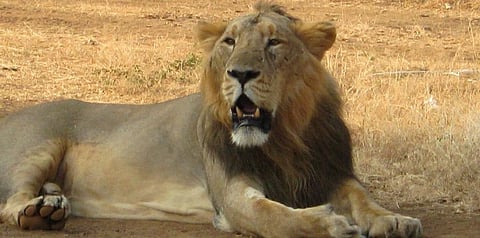Wildlife Week: Trade in bones, taxonomic reclassification potential threats for Asiatic lions
The trade of lion bones is a complicated issue, resulting from divergent political, commercial and ethical perceptions of lion range countries in Africa.
International trade in wild lion parts is illegal under the Convention on International Trade in Endangered Species of Wild Fauna and Flora or CITES as well as all African national legislations. Legal commercial trade in captive-bred lion skeletons is however permitted under CITES Appendix II and over 6,000 skeletons have been exported from South Africa to southeast Asia since 2008.
Many in southeast and east Asia believe lion bones to be useful in traditional medicines. A 2015 study in the journal Nature raised the possibility of them being used as substitutes for tiger bones.
The majority of skeletons in the legal commercial trade have come as a by-product of the captive-bred hunting trade in South Africa. In addition to recent demand for lion skeletons in Asia, there is long-standing traditional and cultural use of lion bones and body parts within Africa.
The legal international lion bone trade is a contentious issue for a number of reasons. These include the concern that the apparent recent demand for lion bones may have an impact on wild lion populations across its range, triggering poaching, illegal killing of ‘conflict’ animals and sale of their body parts.
In addition, the potential for trafficking of lion body parts to Asia through both legal and illegal channels of international trade is a growing concern.
Discussions on these concerns among lion range countries in the 17th Conference of Parties to the United Nations Climate Change Framework Convention in 2016 resulted in an annotation. It restricted commercial trade to captive lions subject to an annual quota but failed to agree upon up-listing African lions to Appendix I, from Appendix II.
As a consequence, the challenge of validating legally exported body parts and monitoring the impact it would have on wild lion populations across its range gains greater prominence.
Proper strategy needed
India — home to the only Asiatic lion population — has been serious in providing the highest legal protection to the species under Schedule I of the Wild Life (Protection) Act, 1972. The country is also stringent about any allowances on trade related to wildlife species.
It has also been able to prevail upon other countries to recognise these concerns. For instance, Asiatic lions were moved to Appendix I from Appendix II as early as 1977, thereby keeping the prospects of trade air-tight since over three decades.
In 2007, the poaching of lions in the Gir Protected Area was halted before any disastrous consequences. However, at this time, the International Union for the Conservation of Nature (IUCN) downgraded the status of Asiatic lions to ‘Endangered’ from ‘Critically Endangered’. This, even when the threats of extinction of a single restricted population are applicable according to IUCN red-list criteria.
Yet another concern is the recent reclassification of the subspecies of Panthera leo, that groups Asiatic lions with north, central and west African lions as Panthera leo leo, no longer giving them a distinctive sub-species classification as leo persica.
Basing these decisions on taxonomic merits alone may be a setback for conservation planning. The implications of these decisions are yet to be deliberated in international fora.
An attempt to split the listing of lions under CITES appendices based on the region-wise status of African lions, with concerns for central and west African lions, have been unsuccessful. This, therefore, further impacts international policies for Asiatic lions.
Concerns about illegal trade of African lion parts, can have a greater impact on Asiatic lions due to their relative proximity to the Asian markets.
Vying for attention with the greatly championed and more widespread Indian tigers, Asiatic lions may be fighting a difficult battle. This concern is compounded as lion bones increasingly substitute tiger bones in the trade arena, are less represented by Indian scientific contingents and there being an overall lack of vision for this subspecies.
There seems negligible accommodation of Asian scientists in working groups where there appears to be a clash of perceptions rather than consensus. Bauer et al (2018) opine that Indian delegations can add more weight to debates on trade and lion conservation and play a more positive role as moderators for wildlife-centric arguments. This may add strength to conserving the central and west African lions.
Overall, the Asiatic lion is restricted by range, representation and respect. We need to award a real leadership role for Asiatic lions rather than having them end up as hapless victims of distant decisions.
Meena Venkataraman is a wildlife biologist specialising in Asiatic lions. She is also principal consultant at Carnivore Conservation & Research and member of the African Lion Working Group


